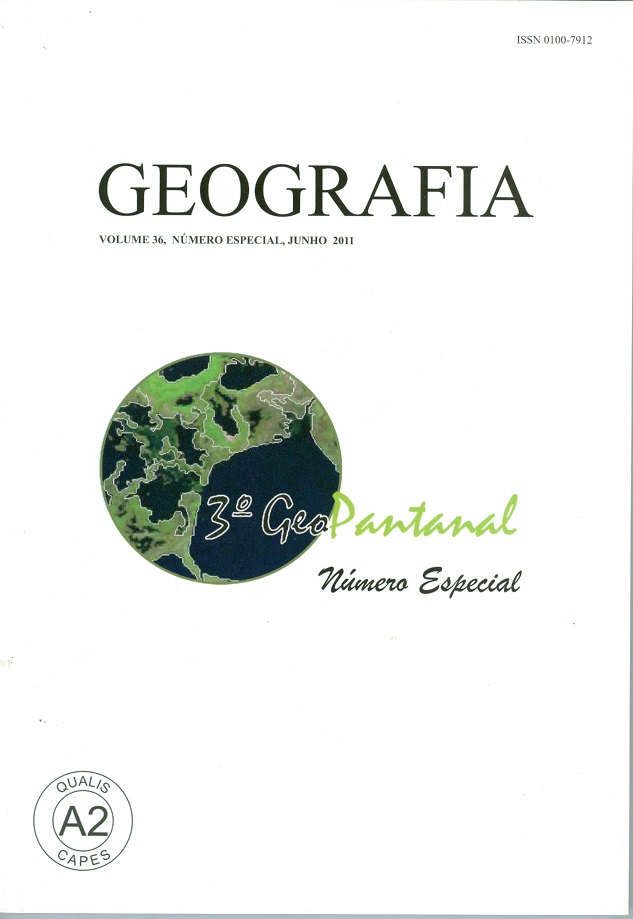VEGETATION INDEX PERFORMANCE FOR THE PANTANAL REGION DURING BOTH DRY AND RAINY SEASONS
Resumen
This study aims to evaluate the performance of NDVI, EVI and LSWI in the Pantanal, considering the main types of land cover and seasonal rainfall. For this purpose, we used data from MODIS and TRMM monthly rainfall estimates. For the dry season, results varied between NDVI (0.4 and 0.8); LSWI (0.0 and 0.4); EVI (0.2 and 0.6). All indices also showed a poor correlation with rainfall, which was below 0.25. In the rainy season, NDVI presented the highest values, between 0.6 and 0.8. Only in some sections of the Evergreen Forest class, LSWI values were higher than the NDVI. The EVI showed values between 0.2 and 0.5 and the LSWI showed intermediate values between the NDVI and EVI from 0.2 to 0.7. Although alternating at times, the Savannah (Cerrado) and Deciduous Tropical Forest (Chaco) classes, LSWI and EVI were very similar. The NDVI and LSWI showed significant correlations with rainfall in all land cover classes. The LSWI showed the greatest amplitude, in all classes, and for both seasons, indicating to be most suitable for studies in the Pantanal, especially for the Savannah and Deciduous Tropical Forest classes during the rainy season, and Evergreen Forest class during the dry season. Key words: NDVI. EVI. LSWI. Rainfall. TRMM. Desempenho de índices de vegetação na região do pantanal nas estações seca e chuvosa Este trabalho avalia o desempenho dos índices de vegetação NDVI, EVI e LSWI no Pantanal, considerando os principais tipos de cobertura da terra e a sazonalidade da precipitação. Foram utilizados dados do sensor MODIS e estimativas de precipitação do satélite TRMM. Os resultados mostraram que, na estação seca, os valores de NDVI, LSWI e EVI variaram entre 0,4 e 0,8; 0,0 e 0,4; e 0,2 e 0,6, respectivamente. Todos os índices mostraram baixa correlação com a precipitação, inferiores a 0,25. Na estação chuvosa, o NDVI apresentou os maiores valores, entre 0,6 e 0,8. Apenas em alguns setores da classe Floresta Perene, os valores de LSWI superaram os de NDVI. O EVI apresentou os valores mais baixos, entre 0,2 e 0,5, enquanto o LSWI apresentou valores intermediários, entre 0,2 e 0,7. Nas classes Cerrado e Chaco, o LSWI e o EVI ficaram bastante próximos. O NDVI e o LSWI mostraram correlações significativas com a precipitação em todas as classes de cobertura. O LSWI apresentou a maior amplitude em ambas às estações, e em todas as classes, mostrando ser o índice mais adequado para estudos no Pantanal, especialmente para as classes Cerrado e Chaco na estação chuvosa, e Floresta Perene na estação seca. Palavras-chave: NDVI. EVI. LSWI. Precipitação. TRMM.Descargas
Publicado
Número
Sección
Licencia
Los autores mantienen los derechos de autor y otorgan a GEOGRAFIA el derecho de primera publicación, estando los artículos licenciados simultáneamente bajo la Licencia Creative Commons BY 4.0, que permite compartir y adaptar los artículos para cualquier propósito, siempre que se cumplan los créditos y disposiciones de derechos de imagen, privacidad. o derechos morales. Se puede acceder a otras atribuciones legales en: https://creativecommons.org/licenses/by/4.0/legalcode.en.

Geografia, Rio Claro, SP, Brasil- eISSN 1983-8700 - Licencia Creative Commons BY 4.0,





